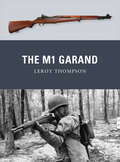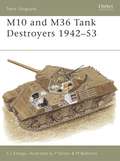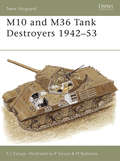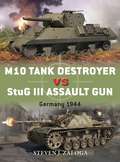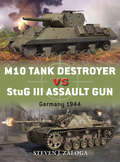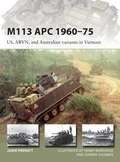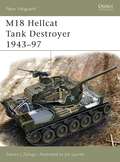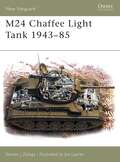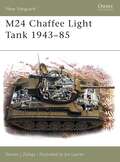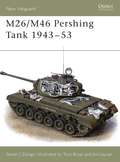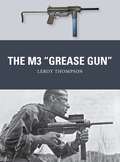- Table View
- List View
The M1 Garand (Weapon #16)
by Peter Dennis Leroy Thompson Alan GillilandThe M1 Garand gave the US infantryman a marked edge during World War II. It shot faster and further than enemy infantry rifles and hit harder. No less an authority on killing the enemy than General George S. Patton called the Garand, "The greatest battle implement ever devised.†? At a time when opposing forces were armed with bolt-action rifles, US troops had a highly reliable self-loader. The eight-round clips which were used to load the M1 Garand were, however, viewed with mixed emotions by the troops on the ground. Some Army and Marine Corps troops allegedly felt that the distinctive "twang†? as the Garand's clip was ejected when empty alerted the enemy that the soldiers were reloading and resulted in an attack. But the Garand became the defining mankiller of the war, despite its weight and magazine problems, and many US combat veterans consider it one of the key reasons they survived the war.
The M1 Garand (Weapon #16)
by Leroy ThompsonThe M1 Garand gave the US infantryman a marked edge during World War II. It shot faster and further than enemy infantry rifles and hit harder. No less an authority on killing the enemy than General George S. Patton called the Garand, “The greatest battle implement ever devised.” At a time when opposing forces were armed with bolt-action rifles, US troops had a highly reliable self-loader. The eight-round clips which were used to load the M1 Garand were, however, viewed with mixed emotions by the troops on the ground. Some Army and Marine Corps troops allegedly felt that the distinctive “twang” as the Garand's clip was ejected when empty alerted the enemy that the soldiers were reloading and resulted in an attack. But the Garand became the defining mankiller of the war, despite its weight and magazine problems, and many US combat veterans consider it one of the key reasons they survived the war.
M10 and M36 Tank Destroyers 1942–53 (New Vanguard)
by Steven J. Zaloga Peter SarsonThe US Army had a unique tactical doctrine during World War II, placing the emphasis for tank fighting on its Tank Destroyer Command whose main early-war vehicle was the M10 3-inch Gun Motor Carriage, based on the reliable M4A2 Sherman tank chassis. This durable and versatile vehicle saw combat service from the North Africa campaign in 1943. By 1944, its gun was not powerful enough and it was rearmed with the new 90 mm gun, becoming the M36 90mm Gun Motor Carriage. This book details one of the only US armoured vehicles capable of dealing with the Panther and Tiger during the Battle of the Bulge.
M10 and M36 Tank Destroyers 1942–53 (New Vanguard)
by Steven J. Zaloga Peter SarsonThe US Army had a unique tactical doctrine during World War II, placing the emphasis for tank fighting on its Tank Destroyer Command whose main early-war vehicle was the M10 3-inch Gun Motor Carriage, based on the reliable M4A2 Sherman tank chassis. This durable and versatile vehicle saw combat service from the North Africa campaign in 1943. By 1944, its gun was not powerful enough and it was rearmed with the new 90 mm gun, becoming the M36 90mm Gun Motor Carriage. This book details one of the only US armoured vehicles capable of dealing with the Panther and Tiger during the Battle of the Bulge.
M10 Tank Destroyer vs StuG III Assault Gun: Germany 1944 (Duel)
by Steven J. Zaloga Richard ChasemoreThe Allies' M10 Tank Destroyer and the Germans' Sturmgeschütz (StuG) lll were the unsung workhorses of the northwest European battlefields of 1944–45. While their mission was not principally fighting one another, their widespread use ensured their frequent encounters, from the Normandy Bocage, to the rubble-strewn streets of Aachen. The StuG lll was the quintessential assault gun, a low-slung, heavily armoured, turret-less vehicle intended to provide direct fire support for infantry formations, whilst the M10 3in Gun Motor Carriage was originally developed as a tank destroyer. However, by 1944 the 3in gun proved ineffectual against the most thickly armored German tanks, and was consequently relegated to infantry support too. Widely deployed in roles their designers had not envisaged, these two armoured fighting vehicles clashed repeatedly during the 11-month campaign, which saw the Allies advance from Normandy to the heart of the Reich. Fully illustrated with specially commissioned artwork, this is the story of their confrontation at the height of World War ll.
M10 Tank Destroyer vs StuG III Assault Gun: Germany 1944 (Duel #53)
by Steven J. Zaloga Richard ChasemoreThe Allies' M10 Tank Destroyer and the Germans' Sturmgeschütz (StuG) lll were the unsung workhorses of the northwest European battlefields of 1944–45. While their mission was not principally fighting one another, their widespread use ensured their frequent encounters, from the Normandy Bocage, to the rubble-strewn streets of Aachen. The StuG lll was the quintessential assault gun, a low-slung, heavily armoured, turret-less vehicle intended to provide direct fire support for infantry formations, whilst the M10 3in Gun Motor Carriage was originally developed as a tank destroyer. However, by 1944 the 3in gun proved ineffectual against the most thickly armored German tanks, and was consequently relegated to infantry support too. Widely deployed in roles their designers had not envisaged, these two armoured fighting vehicles clashed repeatedly during the 11-month campaign, which saw the Allies advance from Normandy to the heart of the Reich. Fully illustrated with specially commissioned artwork, this is the story of their confrontation at the height of World War ll.
M103 Heavy Tank 1950–74 (New Vanguard #197)
by Richard Chasemore Kenneth W EstesThe T43 design represented the pinnacle of U.S. Army tank engineering of the late 1940s. The heavy tank proved fairly popular with its crews, who above all respected the powerful armament it carried. The outbreak of war in Korea brought a rush order in December 1950 which led to a complete production run of 300 vehicles. After 1951, the Marine Corps alone retained confidence in the heavy tank program, investing its scarce funds in the improvements necessary to bring about its fielding after a hurried production run in midst of the 'tank crisis' of the year 1950-51. The eventual retirement of the M103 in 1972, over 20 years after manufacture and after 14 years of operational service, demonstrated the soundness of its engineering. It may have been the unwanted 'ugly duckling' of the Army, which refrained from naming the M103 alone of all its postwar tanks. For the Marine Corps, it served the purpose defined for it in 1949 until the automotive and weapons technology of the United States could produce viable alternatives.
M103 Heavy Tank 1950–74 (New Vanguard #197)
by Richard Chasemore Kenneth W EstesThe T43 design represented the pinnacle of U.S. Army tank engineering of the late 1940s. The heavy tank proved fairly popular with its crews, who above all respected the powerful armament it carried. The outbreak of war in Korea brought a rush order in December 1950 which led to a complete production run of 300 vehicles. After 1951, the Marine Corps alone retained confidence in the heavy tank program, investing its scarce funds in the improvements necessary to bring about its fielding after a hurried production run in midst of the 'tank crisis' of the year 1950-51. The eventual retirement of the M103 in 1972, over 20 years after manufacture and after 14 years of operational service, demonstrated the soundness of its engineering. It may have been the unwanted 'ugly duckling' of the Army, which refrained from naming the M103 alone of all its postwar tanks. For the Marine Corps, it served the purpose defined for it in 1949 until the automotive and weapons technology of the United States could produce viable alternatives.
M113 APC 1960–75: US, ARVN, and Australian variants in Vietnam (New Vanguard)
by Johnny Shumate Henry Morshead Jamie PrenattThe M113 is the most widely used and versatile armoured vehicle in the world. Fielded in 1960 as a simple 'battlefield taxi', over 80,000 M113s would see service with 50 nations around the world and 55 years later, many thousands are still in use. In addition to its original role of transporting troops across the battlefield, specialized versions perform a multitude of other functions including command and control, fire support, anti-tank and anti-aircraft defence, and casualty evacuation.This new fully illustrated study examines the service record of the M113 from its initial fielding through to the end of the Vietnam War. It will also describe the many US, South Vietnamese, and Australian variants of the M113 used in the Vietnam War as well as information on tactics, unit tables of organization and equipment, and a selection of engagements in which the M113 played a decisive role.
M113 APC 1960–75: US, ARVN, and Australian variants in Vietnam (New Vanguard)
by Johnny Shumate Henry Morshead Jamie PrenattThe M113 is the most widely used and versatile armoured vehicle in the world. Fielded in 1960 as a simple 'battlefield taxi', over 80,000 M113s would see service with 50 nations around the world and 55 years later, many thousands are still in use. In addition to its original role of transporting troops across the battlefield, specialized versions perform a multitude of other functions including command and control, fire support, anti-tank and anti-aircraft defence, and casualty evacuation.This new fully illustrated study examines the service record of the M113 from its initial fielding through to the end of the Vietnam War. It will also describe the many US, South Vietnamese, and Australian variants of the M113 used in the Vietnam War as well as information on tactics, unit tables of organization and equipment, and a selection of engagements in which the M113 played a decisive role.
The M14 Battle Rifle (Weapon #37)
by Leroy ThompsonThe M14 may have only been the primary US service rifle for a little over a decade before being replaced by the M16, but it is still considered by many experts to be the best rifle to ever see US service. Primarily designed for a war in Europe, where it would take its place alongside the other battle rifles like the FN FAL, the M14 saw most of its combat use in the early days of the Vietnam War. Maintained until 1970 for compatibility with NATO forces the M14 had a renaissance as a semi-automatic sniping weapon and since 2001 the M14 has been employed as a Designated Marksman Rifle, being employed by all branches of the US military, especially in Afghanistan where the open terrain makes longer-range engagements common. Featuring specially commissioned full-color artwork and archive and close-up photographs, this engaging study tells the story of the M14, the long-lived battle rifle that remains in front-line service with US forces more than 50 years after its first adoption.
The M14 Battle Rifle (Weapon)
by Leroy Thompson Johnny Shumate Alan GillilandThe M14 may have only been the primary US service rifle for a little over a decade before being replaced by the M16, but it is still considered by many experts to be the best rifle to ever see US service. Primarily designed for a war in Europe, where it would take its place alongside the other battle rifles like the FN FAL, the M14 saw most of its combat use in the early days of the Vietnam War. Maintained until 1970 for compatibility with NATO forces the M14 had a renaissance as a semi-automatic sniping weapon and since 2001 the M14 has been employed as a Designated Marksman Rifle, being employed by all branches of the US military, especially in Afghanistan where the open terrain makes longer-range engagements common. Featuring specially commissioned full-color artwork and archive and close-up photographs, this engaging study tells the story of the M14, the long-lived battle rifle that remains in front-line service with US forces more than 50 years after its first adoption.
The M16 (Weapon #14)
by Gordon L. RottmanThe M16 was first introduced in 1958 and was revolutionary for its time as it was made of lightweight materials including special aluminum and plastics. It was first adopted by US Special Forces and airborne troops in 1962 before it was issued to Army and Marine units serving in Vietnam. Its use spread throughout the following decades and a number of variants including submachine and carbine versions were also fielded. As a result it is now amongst the three most used combat cartridges in the world while over 10 million M16s and variants have been produced making it one of the most successful American handheld weapons in history .But despite its undeniable success the M16 is not without its detractors. Indeed, the “black rifle”, as it is known, is one of the most controversial rifles ever introduced with a long history of design defects, ruggedness issues, cleaning difficulties and reliability problems leading to endless technical refinements. This volume provides a technical history of the M16 and the struggle to perfect it together with an assessment of its impact on the battlefield drawing on over a decade's combat experience with the rifle.
The M16 (Weapon)
by Gordon L. Rottman Johnny Shumate Alan GillilandThe M16 was first introduced in 1958 and was revolutionary for its time as it was made of lightweight materials including special aluminum and plastics. It was first adopted by US Special Forces and airborne troops in 1962 before it was issued to Army and Marine units serving in Vietnam. Its use spread throughout the following decades and a number of variants including submachine and carbine versions were also fielded. As a result it is now amongst the three most used combat cartridges in the world while over 10 million M16s and variants have been produced making it one of the most successful American handheld weapons in history .But despite its undeniable success the M16 is not without its detractors. Indeed, the "black rifle†?, as it is known, is one of the most controversial rifles ever introduced with a long history of design defects, ruggedness issues, cleaning difficulties and reliability problems leading to endless technical refinements. This volume provides a technical history of the M16 and the struggle to perfect it together with an assessment of its impact on the battlefield drawing on over a decade's combat experience with the rifle.
M18 Hellcat Tank Destroyer 1943–97 (New Vanguard)
by Steven J. Zaloga Jim LaurierThe M18 76mm Gun Motor Carriage was developed for the US Army's Tank Destroyer Command. It was the only tank destroyer deployed during World War II actually based on their requirements for speed and firepower. This book examines the development of this vehicle, the controversies over the need for high-speed tank destroyers, and its actual performance during World War II. Special emphasis is placed on examining its performance in its intended mission. Coverage also includes derivative vehicles of the M18 such as the M39 armored utility vehicle.
M18 Hellcat Tank Destroyer 1943–97 (New Vanguard #97)
by Steven J. Zaloga Jim LaurierThe M18 76mm Gun Motor Carriage was developed for the US Army's Tank Destroyer Command. It was the only tank destroyer deployed during World War II actually based on their requirements for speed and firepower. This book examines the development of this vehicle, the controversies over the need for high-speed tank destroyers, and its actual performance during World War II. Special emphasis is placed on examining its performance in its intended mission. Coverage also includes derivative vehicles of the M18 such as the M39 armored utility vehicle.
The M1903 Springfield Rifle (Weapon)
by Steve Noon Leroy Thompson Alan GillilandDeveloped to replace the Model 1892 Krag-Jørgensen rifle, the Model 1903 Springfield was a five-shot bolt-action rifle that introduced the .30-06 cartridge – the standard US round until the introduction of the 7.62mm NATO cartridge – and gave the US infantryman a durable, magazine-fed weapon so renowned for its accuracy that it remained in service as a sniping rifle for decades after it was superseded by the M1 Garand in 1937. Extensively used in World War I, the M1903 Springfield saw widespread combat in World War II and Korea. During World War I, US troops developed a formidable reputation for marksmanship aided by the accuracy of the M1903 Springfield. World War II saw the introduction of the M1903A3, which changed the rear sight so that it was closer to that of the M1 Garand, to allow easier training of troops who might be issued either rifle. Illustrated with specially commissioned color artwork and drawing upon veterans' recollections, this is the engaging story of the M1903 Springfield, an iconic rifle prized for its lethal accuracy that equipped US and other troops for much of the 20th century.
The M1903 Springfield Rifle (Weapon #23)
by Leroy Thompson Alan Gilliland Mr Steve NoonDeveloped to replace the Model 1892 Krag-Jørgensen rifle, the Model 1903 Springfield was a five-shot bolt-action rifle that introduced the .30-06 cartridge – the standard US round until the introduction of the 7.62mm NATO cartridge – and gave the US infantryman a durable, magazine-fed weapon so renowned for its accuracy that it remained in service as a sniping rifle for decades after it was superseded by the M1 Garand in 1937. Extensively used in World War I, the M1903 Springfield saw widespread combat in World War II and Korea. During World War I, US troops developed a formidable reputation for marksmanship aided by the accuracy of the M1903 Springfield. World War II saw the introduction of the M1903A3, which changed the rear sight so that it was closer to that of the M1 Garand, to allow easier training of troops who might be issued either rifle. Illustrated with specially commissioned color artwork and drawing upon veterans' recollections, this is the engaging story of the M1903 Springfield, an iconic rifle prized for its lethal accuracy that equipped US and other troops for much of the 20th century.
M1A2 Abrams Main Battle Tank 1993–2018 (New Vanguard)
by Steven J. ZalogaSince the Gulf War, the Abrams tank has undergone a transformation, while fighting in conflicts across the world. Its M1A1 and M1A2 variants have seen great improvements made to this iconic tank, including in fire-control, armour protection, and thermal imaging technology. Involvement in the conflicts in Iraq and Afghanistan necessitated a number of upgrades and modifications as the United States fought two of its longest wars. Recent years have seen new variants of the series such as the ABV Assault Breacher Vehicle and M104 Wolverine Heavy Assault Bridge. Over the past few decades, the M1A1 Abrams has also been extensively exported and is license produced in Egypt. The long-awaited follow-up to NVG 2 M1 Abrams Main Battle Tank 1982–92 (1993), this fully illustrated study examines the Abrams tanks' last quarter-century of service with both the United States and its various foreign operators with a focus on its combat history.
M1A2 Abrams Main Battle Tank 1993–2018: 1993-2018 (New Vanguard #268)
by Steven J. ZalogaSince the Gulf War, the Abrams tank has undergone a transformation, while fighting in conflicts across the world. Its M1A1 and M1A2 variants have seen great improvements made to this iconic tank, including in fire-control, armour protection, and thermal imaging technology. Involvement in the conflicts in Iraq and Afghanistan necessitated a number of upgrades and modifications as the United States fought two of its longest wars. Recent years have seen new variants of the series such as the ABV Assault Breacher Vehicle and M104 Wolverine Heavy Assault Bridge. Over the past few decades, the M1A1 Abrams has also been extensively exported and is license produced in Egypt. The long-awaited follow-up to NVG 2 M1 Abrams Main Battle Tank 1982–92 (1993), this fully illustrated study examines the Abrams tanks' last quarter-century of service with both the United States and its various foreign operators with a focus on its combat history.
M24 Chaffee Light Tank 1943–85 (New Vanguard)
by Steven J. ZalogaThe history of US light tanks during World War II is a chequered one. The Light Battalions of US Armored Divisions were initially filled with M3A1 and M5 Stuart tanks, however, on the battlefields of North Africa it was realised that these were disastrously under armoured and gunned, and a replacement, or the abandonment of light tank doctrine, was desperately needed. It wasn't until the last few months of WWII that the M24 Chaffee came into service and it was extensively used in combat from the Battle of the Bulge to the final campaigns in Germany. This book will trace the history of this design, its combat record in World War II, its many variants, and its extensive combat record post 1945.
M24 Chaffee Light Tank 1943–85 (New Vanguard)
by Steven J. ZalogaThe history of US light tanks during World War II is a chequered one. The Light Battalions of US Armored Divisions were initially filled with M3A1 and M5 Stuart tanks, however, on the battlefields of North Africa it was realised that these were disastrously under armoured and gunned, and a replacement, or the abandonment of light tank doctrine, was desperately needed. It wasn't until the last few months of WWII that the M24 Chaffee came into service and it was extensively used in combat from the Battle of the Bulge to the final campaigns in Germany. This book will trace the history of this design, its combat record in World War II, its many variants, and its extensive combat record post 1945.
M26/M46 Pershing Tank 1943–53 (New Vanguard #35)
by Steven J. ZalogaFrom the moment that the M4 Sherman had been matched against German Panther and Tiger tanks, the American tank crews had known that their vehicles were outclassed by the opposition. What was needed was a more powerful tank, more heavily armed and armored, that could take-on the powerful German panzers on a more equal footing. Although it took time to develop by the latter months of the war numbers of M26 Pershing tanks were reaching the frontline US armored units. Well armored and with a powerful 90mm gun the Pershing was a match for any tank in the German order of battle.
M26/M46 Pershing Tank 1943–53 (New Vanguard #35)
by Steven J. Zaloga Jim Laurier Tony BryanFrom the moment that the M4 Sherman had been matched against German Panther and Tiger tanks, the American tank crews had known that their vehicles were outclassed by the opposition. What was needed was a more powerful tank, more heavily armed and armored, that could take-on the powerful German panzers on a more equal footing. Although it took time to develop by the latter months of the war numbers of M26 Pershing tanks were reaching the frontline US armored units. Well armored and with a powerful 90mm gun the Pershing was a match for any tank in the German order of battle.
The M3 "Grease Gun" (Weapon)
by Adam Hook Leroy Thompson Alan GillilandInfluenced by the German MP 40 and the British Sten, the .45-caliber M3 "Grease Gun†? served as the primary US submachine gun for almost a half-century. Designed to replace the expensive Thompson SMG, the M3 was issued to airborne troops and others during World War II thanks to its compact design with sliding wire stock. An improved variant, the M3A1, was favored by armored crews right up to the beginning of the 1990s, seeing service in 1991's Operation Desert Storm. In Korea and Vietnam, reconnaissance troops and special-operations forces were at times armed with the M3A1 – also available in a suppressed version – and it was the first SMG issued to the US counterterrorist unit Delta Force. Featuring full-color artwork, first-hand accounts, and archive and close-up photographs, this is the engaging story of the M3 submachine gun.

